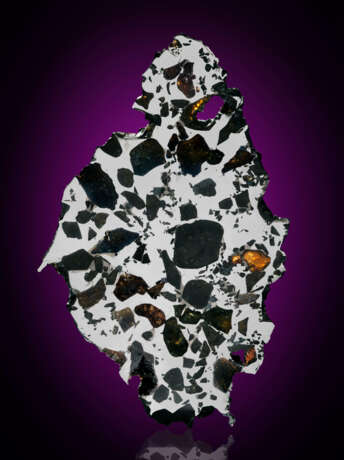ID 716446
Lot 61 | MARJALAHTI — NOTABLE OFFERING OF AN EXTREMELY RARE WITNESSED PALLASITE FALL
Estimate value
$ 18 000 – 25 000
A local newspaper reported, “A magnificent natural phenomenon was seen here in Kurkijoki on the 1st of June at around 22:00 o’clock. It was like a glowing ball followed with a long, but narrow fire tail. The size of the fireball was half the size of the Moon. It seemed to break apart or exploded. After a couple of minutes, a thunder-like sound was heard.”
Marjalahti struck a granite outcrop. Its finder, believing he was blessed with otherworldly riches, dipped the meteorite in acid to remove the still gleaming crystals from the nickel-iron matrix. His fascination is understandable; Marjalahti features chartreuse olivine and peridot (the birthstone of August). Marjalahti weighed 45 kg upon its recovery and its main mass — from which this endpiece is derived — is on display at the Finnish Geological Museum in Helsinki. As a result of the purity of its olivine, it was determined that Marjalahti olivine should be the international standard for olivine composition, and so scores of crystals were plucked and distributed to labs and research centers for the calibration of scientific instruments. Only several kilograms of sliced Marjalahti with intact olivine crystals are available to the public, and the current offering is the smooth end of the meteorite. The other end, which is on display at the Maine Mineral & Gem Museum, exhibits a tangled webbing of metal at its periphery — the result of extraction of olivine crystals. For meteorite cognoscenti, this is a notable offering of an important specimen of a singularly distinguished meteorite.
Christie's would like to thank Dr. Alan E. Rubin at the Department of Earth, Planetary, and Space Sciences, University of California, Los Angeles for his assistance in preparing this catalogue.
59 x 99 x 18mm (2.33 x 4 x 0.75 in.) and 139.94g (0.33 lbs)
| Address of auction |
CHRISTIE'S 8 King Street, St. James's SW1Y 6QT London United Kingdom | |
|---|---|---|
| Preview |
| |
| Phone | +44 (0)20 7839 9060 | |
| Buyer Premium | see on Website | |
| Conditions of purchase | Conditions of purchase |




